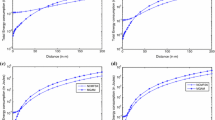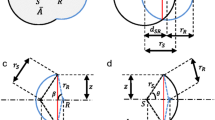Abstract
Recently the energy efficiency (EE) in wireless communication is becoming one of the key performance metric for wireless communicating systems. For battery driven system like wireless sensor networks and ad-hoc networks, the energy conservation is a critical factor for node life. In addition, the spectral efficiency (SE) has been traditionally used as a performance index for wireless transmission. This paper investigates the optimum spectral to energy efficiency tradeoff especially for short range communications. The analysis starts with the Shannon case in additive white gaussian noise channel where some theoretic results are developed when considering both transmit and circuit energy. Then, point to point communication system with uncoded M-ary quadrature amplitude modulation (MQAM) is considered. At the device layer, a system level power consumption model is proposed. At the physical layer, a novel and accurate approximation of the bit error rate (BER) function of the signal to noise ratio is made. The total energy per bit is formulated and the link between the Shannon limit capacity and MQAM based communication is established. The impact of distance, bandwidth, power consumption and BER as a quality-of-service parameter on EE–SE tradeoff is analyzed. It is shown that, varying distance, bandwidth and circuit power consumption induce more impact in the low SE regime whereas, the BER has more impact on the high SE regime. Moreover, the energy optimal spectral efficiency for MQAM is obtained in closed-form and confirmed by numerical results.









Similar content being viewed by others
References
Chen, Y., Zhang, S., Shugong, X., & Li, G. Y. (2011). Fundamental trade-offs on green wireless networks. IEEE Communications Magazine, 49(6), 30–37.
Moore, G. E. (1998). Cramming more components onto integrated circuits. Proceedings of the IEEE, 86(1), 82–85.
Stankovic, J., et al. (2014). Research directions for the internet of things. IEEE Internet of Things Journal, 1(1), 3–9.
Goldsmith, A. J., & Wicker, S. B. (2002). Design challenges for energy-constrained ad hoc wireless networks. IEEE Wireless Communications, 9(4), 8–27.
Clavier, L., & Loyez, C. (2015). Rèseaux de capteurs autonomes couche physique et architectures matèrielles. Techniques de l’ingenieur. S7511 v (1).
Verdu, S. (2002). Specral efficiency in the wideband regime. IEEE Transactions on Information Theory, 48(6), 1319.
Miao, G., Himayat, N., Li, Y., & Swami, A. (2009). Cross-layer optimization for energy-efficient wireless communications: A survey. Wireless Communications and Mobile Computing, 9(4), 529–542.
Massaad, P. Y., Médard, M., & Zheng, L. (2004). Impact of processing energy on the capacity of wireless channels. Proc. IEEE ISITA.
Zhou, C., Li, J., & Cimini Jr, L. J. (2015). Energy efficiency region for Gaussian multiple access channels under different power consumption models. In Information sciences and systems (CISS) (pp. 1–5).
Mahapatra, R., Nijsure, Y., Kaddoum, G., UL Hassan, N., & Yuen, C. (2015). Energy efficiency trade-off mechanism towards wireless green communication: A survey. IEEE Communications Surveys Tutorials, 18(1), 686–705.
Shih, E., Cho, S.-H., Ickes, N., Min, R., Sinha, A., Wang, A., et al. (2001). Physical layer driven protocol and algorithm design for energy-efficient wireless sensor networks. In International conference on Mobile computing and networking (pp. 272–287).
Holland, M., Wang, T., Tavli, B., Seyedi, A., & Heinzelman, W. (2011). Optimizing physical-layer parameters for wireless sensor networks. ACM Transactions on Sensor Networks (TOSN), 7(4), 28.
Shivaprakasha, K. S., Kulkarni, M., & Patkar, R. (2013). Performance analysis of energy efficient modulation and coding schemes for wireless sensor networks. International Journal of Parallel, Emergent and Distributed Systems, 28(6), 576–589.
Wang, A., Cho, S. H., Sodini, C., & Chandrakasan, A. (2001). Energy efficient modulation and MAC for asymmetric RF microsensor systems. In Proceedings of the 2001 international symposium on Low power electronics and design (pp. 106–111).
Rosas, F., & Oberli, C. (2012). Modulation optimization for achieving energy efficient communications over fading channels. In Vehicular technology conference (VTC spring) (pp. 1–5).
Cui, S., Goldsmith, A. J, & Ahmad, B. (2003). Modulation optimization under energy constraints. In IEEE international conference on communications (Vol. 4, pp. 2805–2811).
Cui, S., Goldsmith, A. J., & Bahai, A. (2005). Energy-constrained modulation optimization. Wireless Communications, 4(5), 2349–2360.
Raghunathan, V., Schurgers, C., Park, S., & Srivastava, M. B. (2002). Energy-aware wireless microsensor networks. IEEE Signal Processing Magazine, 19(2), 40–50.
Abouei, J., Plataniotis, K. N., & Pasupathy, S. (2010). Green modulation in dense wireless sensor networks. In Acoustics speech and signal processing (ICASSP) (pp. 3382–3385).
Zardosht, M. J., & Almodarresi, S. M. T. (2012). Energy optimization in multi-hop wireless sensor networks. In International symposium on telecommunications (IST) (pp. 450–454).
Jaouadi, R., Andrieux, G., Baudais, J.-Y., & Diouris, J.-F. (2015). Energy and spectrum trade-off for uncoded MQAM in energy constrained system. In European conference on networks and communications Jun 2015, Paris, France.
Cui, S., Goldsmith, A. J., & Ahmad, B. (2004). Energy-efficiency of mimo and cooperative mimo techniques in sensor networks. Selected Areas Communications, 22(6), 1089–1098.
Heliot, F., Imran, M. A., & Tafazolli, R. (2011). On the energy efficiency gain of MIMO communication under various power consumption models. In Future network mobile summit (pp. 1–9).
van den Heuvel, J. H. C., Wu, Y., Baltus, P. G., & van Roermund, A. H. (2014). Front end power dissipation minimization and optimal transmission rate for wireless receivers. Circuits and Systems I, 61(5), 1566–1577.
Shannon, C. E. (1948). A mathematical theory of communication. Bell System Technical Journal, 27, 379–423.
Bae, C., & Stark, W. E. (2007) Battery-driven system design: A new frontier in low power design. In IEEE military communications conference (pp. 1–7).
Rappaport, T. S., & Murdock, J. N. (2012). Power efficiency and consumption factor analysis for broadband millimeter-wave cellular networks. In Global communications conference (GLOBECOM) (pp. 4518–4523).
Isheden, C., Fettweis, G. P. (2010). Energy-efficient multi-carrier link adaptation with sum rate-dependent circuit power. In Global telecommunications conference (pp. 1–6).
Kim, H. S., & Daneshrad, B. (2008). Energy-aware link adaptation for MIMO-OFDM based wireless communication. In Military communications conference IEEE (pp. 1–7).
Proakis, J. (2008). Digital communication, 5thd ed. New York: McGraw-Hill.
Baudais, J.-Y., Muhammad, F. S., & Hélard, J.-F. (2012). Robustness maximization of parallel multichannel systems. Journal of Electrical and Computer Engineering, 2012, 1.
Karagiannidis, G. K., & Lioumpas, A. S. (2007). An improved approximation for the Gaussian Q-function. IEEE Communications Letters, 11(8), 644–646.
Cho, K., & Yoon, D. (2002). On the general BER expression of one- and two-dimensional amplitude modulations. Communications, 50(7), 1074–1080.
Elmar, W. (1999). Theory and applications in topics in microeconomics: Industrial organization, auctions, and incentives. Cambridge University Press.
Author information
Authors and Affiliations
Corresponding author
Additional information
Publisher's Note
Springer Nature remains neutral with regard to jurisdictional claims in published maps and institutional affiliations.
Appendix
Appendix
1.1 Proof of Lemma 1
The objective function \(E_\mathrm{bt}\) can be bounded as follow: \(\forall t \in ]0,\theta ]\) we have \(1\le e^{t}\le e^{\theta }\) so
Finally, \(E_\mathrm{bt}\) can be approximated to the right hand expression for low \(\theta\) values and to the left hand expression for high \(\theta\) values.
1.2 Proof of Lemma 2
First we express a general form of (4) as follow
To prove the quasi-convexity of (4), we recall that for \(\theta \ge 0\) a function is strictly quasi-convex if
is a strictly convex set for any real number \(\beta\). Note that when \(\beta \le 0\), \(S_{\beta }\) is empty since \(E_\mathrm{bt}(\theta )>0\). Hence \(S_{\beta }\) is strictly convex as no point exist on the contour. Now we investigate the case when \(\beta > 0\). In such case, \(S_{\beta }\) is equivalent to \(S_{\beta }=\left\{ \theta \ge 0 \mid g(\beta ,\,\theta )=A\left( 2^{\theta }-1\right) -\beta \theta \le 0 \right\}\). Since \(g(\beta ,\,\theta )\) is strictly convex in \(\theta\), if we take \(\theta _{1}\) and \(\theta _{2}\) two points of the contour of \(S_{\beta }\) ( \(\theta _{1}>0\) and \(\theta _{2}>0\)) then we have \(\forall \theta \in \left( \theta _{1},\,\theta _{2} \right)\), \(g(\beta ,\,\theta )< \max \left\{ g(\beta ,\,\theta _{1}),\,g(\beta ,\,\theta _{2}) \right\} \le 0\). The first inequality comes from the strict quasi-convexity of \(g(\beta ,\,\theta )\) w.r.t \(\theta\) [34]. Hence, \(S_{\beta }\) is strictly quasi-convex set when \(\beta > 0\). Thus we have the strict quasi-convexity of \(E_\mathrm{bt}(\theta )\).
1.3 Proof of Lemma 3
Setting the derivative of \(E_\mathrm{bt}(\theta )\) with respect to \(\theta\) to zero we try to find the optimum spectral efficiency \(\theta ^{\star }\). After rearranging the terms, we take the following steps
by using the Lambert function \(W_{L}\) since it is the solution to \(x=W_{L}(x)\exp \left( W_{L}(x)\right)\) we have
1.4 Proof of Lemma 5
We begin by establishing the first inequality. Suppose that \(P_\mathrm{pr}\) is independent of d then
The last inequality is due to the fact that \(\theta ^{\star }(d_{1})\) minimizes \(E_\mathrm{bt}\left( \theta (d),\,d_{1}\right)\). To prove the rest of lemma we set the derivative of (4) w.r.t \(\theta\) and let \(q(\theta (d))=\frac{2^{\theta (d)}-1}{\theta (d)}\). By exploiting the fact that \(\theta ^{\star }(d_{1})\) is the solution of \(E_\mathrm{bt}^{\prime }\left( \theta (d),\,d_{1}\right) =0\), the following equality hold
By setting the derivative of \(E_\mathrm{bt}\left( \theta ,\,d\right)\) w.r.t \(\theta\) and using (43) it can be shown that
As \(E_\mathrm{bt}\left( \theta ,\,d\right)\) is strictly quasi-convex so \(E_\mathrm{bt}^{\prime }\left( \theta ,\,d\right) >0\) when \(\theta >\theta ^{\star }(d)\) and \(E_\mathrm{bt}^{\prime }\left( \theta ,\,d\right) <0\) when \(\theta <\theta ^{\star }(d)\). Therefore \(\theta ^{\star }(d_{1}) >\theta ^{\star }(d_{2})\).
Rights and permissions
About this article
Cite this article
Jaouadi, R., Andrieux, G., Baudais, JY. et al. On the Spectral Efficiency of Energy Constrained Short-Range Communicating Systems. Wireless Pers Commun 101, 1101–1122 (2018). https://doi.org/10.1007/s11277-018-5751-0
Published:
Issue Date:
DOI: https://doi.org/10.1007/s11277-018-5751-0




